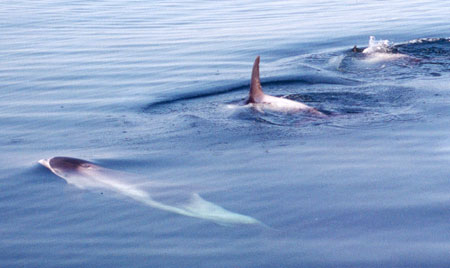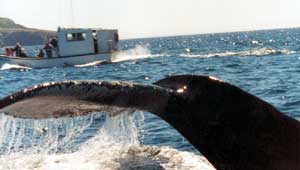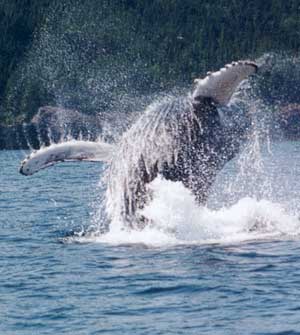Watching
Trips
in
Newfoundland
CoastalSafari@
CoastalSafari.com
Telephone
1-877-888-3020 (Toll free) or
709-579-3977
Mailing Address
50 Monkstown Rd. St. John's, Nfld. Canada. A1C 3T3
click here



At any time when you are on a Coastal Safari tour in Fortune Bay , Newfoundland you can encounter whales, dolphins and porpoises. This past summer the cetacean highlight were the numerous pods of dolphins . When we stopped the boat they came over to check us out, a great photo opportunity.
More details on our wilderness camp and itinerary click here

Our philosophy on whale watching is based on non interference with any animals we encounter.In the vicinity of whales we travel slowly and avoid interference with their feeding or cutting across their path. We limit our close encounter time to a few minutes. In close quarters situations we put our engines in neutral and do not re-engage props until whales are observed at the surface, clear of the vessel.

Large numbers of whales dolphins and porpoises migrate into the waters adjacent to the Newfoundland coast every year. About 15 species are normally present, seasonally or year-round.

Humpbacks are the most well known baleen whales arriving off Eastern
Newfoundland in late spring from their Caribbean winter breeding
grounds. They reach a body length of 53 feet.
Other common baleen whales in Newfoundland waters are Minke and Fin.
Minke whales are the smallest baleen whale in the northwest Atlantic
reaching a length of about 30 feet.
They are common in inshore Newfoundland waters in summer. They
are curious and will often approach boats. The fin whale reaches 75
feet in length and is a common and widely distributed whale in the
northwest Atlantic.
Toothed whales in Newfoundland waters from May to September
include, Killer , Sperm and Pothead. Killer whales reach a length
of 30 feet. They  appear in inshore Newfoundland waters in
small numbers in spring and summer. Other marine mammals are an
important component of their diet. Male sperm whales reach a length of
50 feet or more, while females attain a length of about 38 feet. Only
males visit Eastern Canadian waters in summer, frequenting the
continental slope and offshore waters. Pothead (pilot whales) reach a
length of 20 feet and are common around Newfoundland in summer.
appear in inshore Newfoundland waters in
small numbers in spring and summer. Other marine mammals are an
important component of their diet. Male sperm whales reach a length of
50 feet or more, while females attain a length of about 38 feet. Only
males visit Eastern Canadian waters in summer, frequenting the
continental slope and offshore waters. Pothead (pilot whales) reach a
length of 20 feet and are common around Newfoundland in summer.
White-beaked dolphins are known in Newfoundland as "squidhounds" and reach a length of 10 feet. White-sided dolphins (also known as the jumper) reach about 9 feet in length. They sometimes gather in herds of up to a thousand animals.
The harbour porpoise, called "puffing pigs" by Newfoundlanders only reach a length of 5 feet. They occur close inshore.Blue Whales were almost hunted to extinction but there has been no commercial whale hunting in Canda since 1972. Here is a 1912 picture of a dead Blue Whale.
Sometimes whales run aground. Nobody is sure why. Here is a CBC news story about whales that ran ashore in Point au Gaul, Newfoundland.
Whales have their own language!
Squid are a favourite food of whales. Here is aYoutube Newfoundland Giant Squid clip!
Capelin are also a big item in the diet of Newfoundland whales and here is a clip of whales feeding just off the beach at St. Vincent's in St. Mary's Bay . This is a well know whale watching beach during the capelin run and only a 2 hour drive from St. John's making it an easily accesible location for the traveller on a self drive tour of Newfoundland
The Coastal Safari camp is
an ideal location a whalewatching learning vacation because we
can provide you
with a whalewatching package where you spend your entire vacation on
the water from dawn until dark every day of your trip. Contact us
to
arrange a custom made whale watching learning vacation.
A standard text for a whalewatching learning vacation is Lien and
Kantona's A
Guide to the Photographic Identification of Individual Whales Based on
their Natural and Acquired Markings
Dr. Kantona has been
involved with College
of the Atlantic's marine mammal research group for many years.
The WhaleNet
database catalogues the Humpback Whale Population of the
Gulf of Maine.
Wild Whales a project of the Vancouver Aquarium collects whale data
for the B.C. Cetacean
Sightings Network.
Whales and other mammals in
Canadian waters are regulated by the
Canadian Department of Fisheries and Oceans under the Marine
Mammal Regulations of the Fisheries Act. These regulations are
presently being reviewed in Marine
Mammal Regulations Consultation
Whales are sometimes caught up in
fishing gear. To solve this problem a professor at Memorial
University of Newfoundland and Labrador, Dr. Jon Lien pioneered the
development of practical
techniques to free whales from fishing gear.
During the early years of his work a lot of Dr. Lien's work involved
whale entanglement with cod traps. Since the closing of the Northern
Cod fishery in 1992 the use of cod traps has
dropped almost to zero.
Cod traps were widely used in and around the Witless Bay Ecological
Reserve and it was not unusual for a trap crew to land a million pounds
in a few weeks during a good season.
When whales get tangled in
fishing gear today the Whale Release and
Stranding Group have experts to assist fishers to untangle these
giant mammals and send them safely on their way. They also have a very
good identification
guide on their site.
Here are some other interesting links for
whales we commonly see in Newfoundland waters divided on physiological
lines into baleen, toothed whales and other whales.
BALEEN WHALES
Blue Whale
Sei Whale
Right Whale
Humpback
Whale
Minke
Whale
Fin Whale
TOOTHED WHALES
Killer Whale Also
see NOAA paper on Killer
Whales below
Sperm Whale
Pygmy
Sperm Whale
Pilot Whale
Narwhal and a
link on their extraordinary tusk
Another
link on tusks
Beluga
Northern
Bottlenose Whale
Sowerby's
beaked Whale
White
Beaked Dolphin
White-sided
Dolphin
Common
Dolphin
Harbour
Porpoise
The Official Tourism Guide for Newfoundland and Labrador contains an online
whale guide.
An interesting application available
online is an expert
whale
identification system. You follow a series of identification
questions through and at the end the program identifies your whale!
Christopher
Clark,
Cornell's I.P. Johnson Director of the Bioacoustics Research Program
has shown that whales
in Newfoundland can hear whales in Bermuda!
The Whale
watching web contains a tremendous amount of information on whales
and whalewatching around the world.
If you want to do some
whale watching in the Witless Bay
Ecological Reserve
south of St. John's there are a number of tour boat operators and local
accomodation. We can recommend staying at the Whalewatcher B&B
who
offer a great package of accommodation, whale watching and hiking on
the
East Coast Trail. Here is a youtube clip
from their boat.
The subject of whale behaviour and identification has been studied
extensively and has subsequently generated a signficant body of
scientific studies and literature.
Lien, J. and S. Katona 1990 A Guide to the Photographic Identification of Individual Whales Based on Their Natural and Acquired Markings. Breakwater, St. Johns, Newfoundland. 77 pp
Katona, S., P. Harcourt, J. S. Perkins, and S.D. Kraus (Editors) l980 Humpback Whales. A Catalogue of Individuals Identified by Fluke Photographs. College of the Atlantic, Bar Harbour, ME. l69 pp.
Katona, S.
K., V. Rough, and D. T. Richardson
1993 A Field Guide to Whales, Porpoises and
Seals from Cape Cod to
Newfoundland.
Fourth edition, revised. Smithsonian Institution Press, Washington, DC. 316
pp.
Melville, H.
l85l
Moby
Dick. Click the link for a free downloadable version
of this out of copyright book from Project Gutenberg.
Pryor, K. and
K. S. Norris (Editors) 1991 Dolphin
Societies. Discoveries and Puzzles. University of
California Press, Berkeley. 397 pp. (Field studies and captive
studies of dolphins and killer whale behavior.)
Slijper, E.
J. l979
Whales. Cornell University Press,
Ithaca, NY.
5ll pp. Reprint of l962 edition with new forward, final chapter, and
updated bibliography by R. J. Harrison. (A good basic book,
technical but readable by the layman. Includes chapters on the
history of whales and whaling, evolution, physiology, behavior, sound
production, migration, and distribution. Conservation problems and
efforts reviewed in final chapter.)
Sugarman, P.
1987
Field Guide to the Orca Whales. The Whale
Museum,
Friday Harbor, Washington. 26 pp. (Identification by fins and
markings.)
Baird, R.
2002 Killer Whales of the World.
Voyageur Press, MN. 132 pp.
Beland, P.
1996 Beluga: a Farewell to Whales.
Lyons & Burford, New York. 224 pp. (Belugas in the St.
Lawrence River and why they are dying.)
Bruemmer, F.
1993
The Narwhal: Unicorn of the Sea. Key
Porter
Books, Toronto, Ontario. 144 pp.
Carwardine,
M. (editor) 2002
Whales Dolphins and Porpoises. 2nd
edition. Smithsonian Handbooks. Dorling Kindersley Books,
New
York. 256
pp. (Guidebook: identifications, how to deal with strandings.)
Conner, R. C.
and D. M. Peterson
1994 The Lives of Whales and Dolphins.
Henry Holt & Co., New York. 233 pp.
Corrigan, P. 1994 The Whale Watcher's Guide: whale-watching trips in North America (forward by Roger Payne). Northword Press, Manocqua, Wisconsin. 327 pp.
Cousteau, J. Y. and P. Diole l972 The Whale. Undersea Discoveries of Jacques Yves Cousteau. Doubleday & Co., Garden City, NY. 304pp., photographs. l977 paper edition titled, Whale: Mighty Monarch of the Sea.
l975 Dolphins. Doubleday & Co. Inc., Garden City, NY. 304 pp., photographs, illus. (This series, The Undersea Discoveries of Jacques‑Yves Cousteau, provides excellent photos; however, many errors occur in the text.)
Cousteau, J. Y. and Y. Paccalet 1988 Whales. Harry N Abrams, Inc., New York. 280 pp. (Beautiful photographs. Topics include evolution, behavior, communication, history of whaling.)The Killer Whale is of great interest to whalewatchers worldwide. Reproduced below is a NOAA paper on the subject of Killer Whales that is relevant for Newfoundland waters. STOCK DEFINITION AND GEOGRAPHIC RANGE
Killer whales are characterized as uncommon or rare in waters of the U.S. Atlantic Exclusive Economic Zone (EEZ) (Katona et al. 1988). The 12 killer whale sightings constituted 0.1% of the 11,156 cetacean sightings in the 1978-81 CETAP surveys (CETAP 1982). The same is true for eastern Canadian waters, where the species has been described as relatively uncommon and numerically few (Mitchell and Reeves 1988). Their distribution, however, extends from the Arctic ice-edge to the West Indies. They are normally found in small groups, although 40 animals were reported from the southern Gulf of Maine in September 1979, and 29 animals in Massachusetts Bay inAugust 1986 (Katona et al. 1988). In the U.S. Atlantic EEZ, while their occurrence is unpredictable, they do occur
in fishing areas, perhaps coincident with tuna, in warm seasons (Katona et al. 1988; NMFS unpublished data). In an extensive analysis of historical whaling records, Reeves and Mitchell (1988) plotted the distribution of killer whales in offshore and mid-ocean areas. Their results suggest that the offshore areas need to be considered in present-day distribution, movements, and stock relationships.
Stock definition is unknown. Results from other areas (e.g., the Pacific Northwest and Norway) suggest that social structure and territoriality may be important.
POPULATION SIZE
The total number of killer whales off the eastern U.S. coast is unknown.
Minimum Population Estimate
Present data are insufficient to calculate a minimum population estimate.
Current Population Trend
There are insufficient data to determine the population trends for this species.
CURRENT AND MAXIMUM NET PRODUCTIVITY RATES
Current and maximum net productivity rates are not known for this stock. The maximum net productivity rate was assumed to be 0.04 for purposes of this assessment. This value is based on theoretical calculations showing that cetacean populations may not generally grow at rates much greater than 4% given the constraints of their reproductive life history (Barlow et al. 1995).
POTENTIAL BIOLOGICAL REMOVAL
Potential Biological Removal (PBR) is the product of minimum population size, one-half the maximum productivity rate, and a “recovery” factor (Wade and Angliss 1997). The minimum population size is unknown.
The maximum productivity rate is 0.04, the default value for cetaceans. The “recovery” factor, which accounts for endangered, depleted, threatened stocks, or stocks of unknown status relative to optimum sustainable population (OSP) is assumed to be 0.5 because this stock is of unknown. PBR for the western North Atlantic killer whale is unknown because the minimum population size cannot be determined.
ANNUAL HUMAN-CAUSED MORTALITY
In 1994, one killer whale was caught in the New England multispecies sink gillnet fishery but released alive. No takes were documented in a review of Canadian gillnet and trap fisheries (Read 1994).
Fishery Information Data on current incidental takes in U.S. fisheries are available from several sources. In 1986, NMFS established a mandatory self-reported fishery information system for large pelagic fisheries. Data files are maintained at the Southeast Fisheries Science Center (SEFSC). The Northeast Fisheries Science Center (NEFSC) Fisheries Observer Observer Program was initiated in 1989, and since that year several fisheries have been covered by the program. In late 1992 and in 1993, the SEFSC provided observer coverage of pelagic longline vessels fishing off the Grand Banks (Tail of the Banks) and provides observer coverage of vessels fishing south of Cape Hatteras.
There have been no observed mortalities or serious injuries by NMFS Sea Samplers in the pelagic drift gillnet, pelagic longline, pelagic pair trawl, New England multispecies sink gillnet, mid-Atlantic coastal sink gillnet,
and North Atlantic bottom trawl fisheries.
STATUS OF STOCK
The status of killer whales relative to OSP in U.S. Atlantic EEZ is unknown. Because there are no observed mortalities or serious injury between 1990 and 1995, the total fishery-related mortality and serious injury for this stock is considered insignificant and approaching zero mortality and serious injury rate. The species is not listed as threatened or endangered under the Endangered Species Act. In Canada, the Cetacean Protection Regulations of 1982, promulgated under the standing Fisheries Act, prohibit the catching or harassment of all cetacean species. There are insufficient data to determine the population trends for this species. This is not a strategic stock because, although PBR could not be calculated, there is no evidence of human-induced mortality.
REFERENCES
Barlow, J., S.L. Swartz, T.C. Eagle, and P.R. Wade. 1995. U.S. Marine Mammal Stock Assessments: Guidelines for Preparation, Background, and a Summary of the 1995 Assessments. U.S. Dep. Commer., NOAA Tech.Memo. NMFS-OPR-6, 73 pp.
CETAP. 1982. A characterization of marine mammals and turtles in the mid- and north Atlantic areas of the U.S.outer continental shelf. Cetacean and Turtle Assessment Program, University of Rhode Island. Final Report #AA551-CT8-48 to the Bureau of Land Management, Washington, DC, 538 pp.
Katona, S. K., J. A. Beard, P. E. Girton, and F. Wenzel. 1988. Killer whales (Orcinus orca) from the Bay of Fundy to the Equator, including the Gulf of Mexico. Rit. Fiskideild. 9: 205-224.
Mitchell, E. and R. R. Reeves. 1988. Records of killer whales in the western North Atlantic, with emphasis on eastern Canadian waters. Rit. Fiskideild. 9: 161-193.
Read, A. J. 1994. Interactions between cetaceans and gillnet and trap fisheries in the Northwest Atlantic. Rep. int.Whal. Commn. Special Issue 15: 133-147.
Reeves, R. R. and E. Mitchell. 1988. Killer whale sightings and takes by American pelagic whalers in the North
Atlantic. Rit. Fiskideild. 9: 7-23
Wade P.R., and R.P. Angliss. 1997. Guidelines for assessing marine mammal stocks: Report of the GAMMS
Workshop April 3-5, 1996, Seattle, Washington. U.S. Dep. Commer., NOAA Tech. Memo. NMFS-OPR-
12, 93 pp
![]()
